
Kazi Nazrul Islam was a Bengali poet, writer, musician, and is the national poet of Bangladesh. Nazrul is regarded as one of the greatest poets in Bengali literature. Popularly known as Nazrul, he produced a large body of poetry, music, messages, novels, stories, etc. with themes that included equality, justice, anti-imperialism, humanity, rebellion against oppression and religious devotion. Nazrul's activism for political and social justice as well as writing a poem titled as "Bidrohī", meaning "the rebel" in Bengali, earned him the title of "Bidrohī Kôbi". His compositions form the avant-garde music genre of Nazrul Gīti.
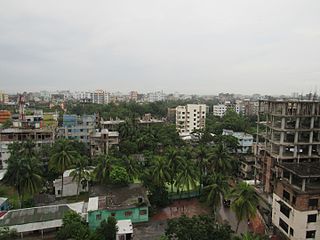
Comilla District, officially known as Cumilla District, is a district of Bangladesh located about 100 kilometres south east of Dhaka. Comilla is bordered by Brahmanbaria and Narayanganj districts to the north, Noakhali and Feni districts to the south, Tripura of India to the east and Munshiganj and Chandpur districts to the west. Comilla district is located in the southeastern part of Bangladesh.
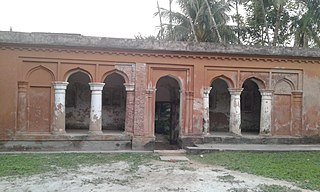
Gopalganj is a district in the Dhaka Division of Bangladesh. The district has about 1,172,415 civilians and its surface area is 1,490 km2. The main city of the district is also called Gopalganj. It stands on the bank of the Madhumati river and located at 23°00’47.67" N 89°49’21.41". It is bounded by Faridpur district on the North, Pirojpur and Bagerhat district on the south, Madaripur & Barisal district on the East and Narail district on the West.
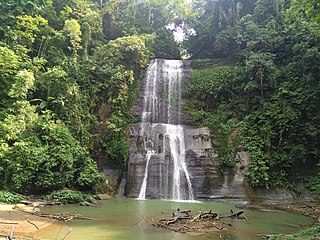
Moulvibazar also spelled Maulvibazar, Moulavibazar, and Maulavibazar, is the southeastern district of Sylhet Division in northeastern Bangladesh, named after the town of Moulvibazar. It is bordered by the Indian states of Tripura and Assam to the south and east, respectively; and by the Bangladeshi districts of Habiganj to the west and Sylhet to the north.

Dhaka College is the oldest secular educational institution of Bangladesh located in New Market, Dhaka 1205. It offers higher secondary education (HSC). It has Honours and Masters programs as well which are affiliated to the University of Dhaka.

Dhaka District is a district in central Bangladesh, and is the densest district in the nation. It is a part of the Dhaka Division. Dhaka, the capital of Bangladesh, and rests on the eastern banks of the Buriganga River which flows from the Turag to the southern part of the district. While Dhaka occupies only about a fifth of the area of Dhaka district, it is the economic, political and cultural centre of the district and the country as a whole. Dhaka District consists with Dhaka, Keraniganj, Nababganj, Dohar, Savar and Dhamrai upazila. Dhaka District is an administrative entity, and like many other cities it does not cover the modern conurbation which is Greater Dhaka, which has spilled into neighbouring districts, nor does the conurbation cover the whole district, as there are rural areas within the district.

Dhaka (Dacca) is one of the oldest inhabited mega cities of the World. The history of Dhaka begins with the existence of urbanised settlements in the area that is now Dhaka dating from the 7th century CE. The city area was ruled by the Hindu Gauda Kingdom, Buddhist and Shaivite Pala Empire before passing to the control of the Hindu Sena dynasty in the 10th century CE. After the Sena dynasty, the city was ruled by the Hindu Deva Dynasty. Dhaka was successively ruled by the Turkic and Afghan governors descending from the Delhi Sultanate, followed by the Bengal Sultanate, before the arrival of the Mughals in 1608. The city became proto-industrialised and declared capital of the Mughal Bengal. The Dhaka natural riverine port has a recorded existence since the 16th century CE. Dhaka's strategic riverine location in Bengal made it a hub for Eurasian traders, including Armenians, the Portuguese, French, Dutch and British. The bustling old city was known as the Venice of the East. After Mughals, British ruled the region for 200 years until the independence of India. In 1947, Dhaka became the capital of the East Bengal province under the Dominion of Pakistan. After the independence of Bangladesh in 1971, Dhaka became the capital of the new state.

Shahbag or Shahbagh is a major neighbourhood and a police precinct or thana in Dhaka, the capital and largest city of Bangladesh. It is also a major public transport hub. It is a junction between two contrasting sections of the city—Old Dhaka and New Dhaka—which lie, respectively, to its south and north. Developed in the 17th century during Mughal rule in Bengal, when Old Dhaka was the provincial capital and a centre of the flourishing muslin industry, it came to neglect and decay in early 19th century. In the mid-19th century, the Shahbag area was developed as New Dhaka became a provincial centre of the British Raj, ending a century of decline brought on by the passing of Mughal rule.
Laksam is an upazila of Comilla District in the Division of Chittagong, Bangladesh. Laksam is widely known as the birthplace of Nawab Faizunnesa Chowdhurani.

Kanaighat is an upazila of Sylhet Division of Bangladesh. It is the second-largest upazila (sub-district) of Sylhet District after Gowainghat Upazila. It is named after the town of Kanaighat, which is also the only municipality in the Upazila.
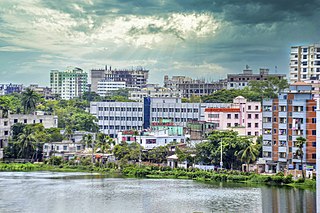
Comilla, officially spelled Cumilla, is the second largest in Chittagong division. It is the administrative centre of the Comilla District. The name Comilla was derived from Komolangko (কমলাঙ্ক), meaning the pond of lotus.
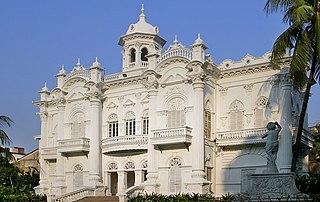
The Rose Garden Palace is a mansion and garden in Old Dhaka, Bangladesh. Built in the late 19th century, it became birthplace of the Awami League in 1949, when East Bengali liberal and social democrats converged in Dhaka to form an alternative political force against the Muslim League in Pakistan.

Old Dhaka is a term used to refer to the historic old city of Dhaka, the capital of Bangladesh. It was founded in 1608 as Jahangirabad or Jahangirnagar, the capital of Mughal Province of Bengal and named after the Mughal emperor Jahangir. It is located on the banks of the Buriganga River. It was one of the largest and most prosperous cities of South Asia and the center of the worldwide muslin trade. The then Nawab of Bengal Murshid Quli Khan shifted the capital from Dhaka to Murshidabad in the early-18th century. With the rise of Calcutta during the British rule, Dhaka began to decline and came to be known as the "City of Magnificent Ruins". The British however began to develop the modern city from the mid-19th century.

Joy Bangla is a slogan and war cry used in Bangladesh to indicate nationalism towards the geopolitical, cultural and historical region of Bengal and Bangamata. It is also recognised as the national slogan of Bangladesh. It translates roughly to "Victory to Bengal" or "Hail Bengal".

Anjuman Mufidul Islam is a Bangladeshi welfare organisation specially designed to enrich the livelihood of orphans and the distressed.

The national symbols of Bangladesh consist of symbols to represent Bangladeshi traditions and ideals that reflect the different aspects of the cultural life and history. Bangladesh has several official national symbols including a historic document, a flag, an emblem, an anthem, memorial towers as well as several national heroes. There are also several other symbols including the national animal, bird, flower and tree.

Baliati Zamindar Bari is in the village of Baliati, in Saturia Upazila in Manikganj District, Bangladesh. It is the palace of the Zamindars, the Baliati Zamindari who ruled over a large area. The Baliati Jamindar Bari is located at 23.9952°N 90.0419°E.
Begum Rokeya Padak, named after Begum Rokeya, is a Bangladeshi national honour conferred on individual women for their exceptional achievement. The award is given by the Ministry of Women and Children Affairs of the Government of Bangladesh. The award recognises the pioneering contribution of an individual in empowering women and raising women's issues.
Kamrunnessa Government Girls High School is a public secondary school for girls in Tikatuli, Dhaka.















